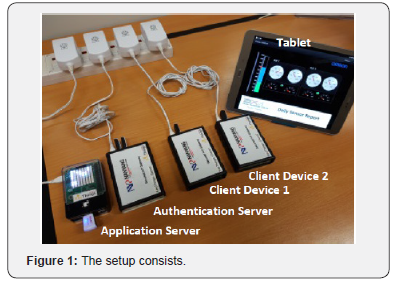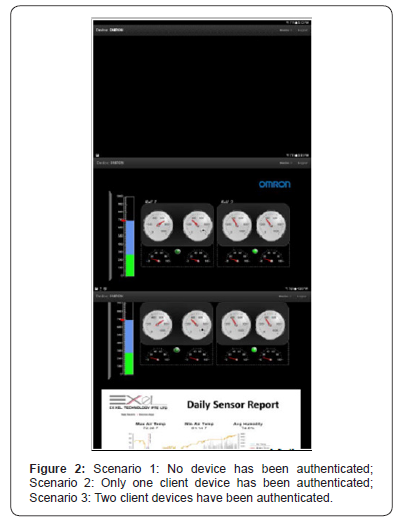Light-Weight Secure IoT Key Generator and Management- juniper Publishers
Juniper Publishers- Journal of Robotics
Abstract
Security is a critical element for IoT deployment
that affects the adoption rate of IoT applications. This paper presents a
Light-Weight Secure IoT Key Generator and Management Solution(LKGM) for
industry automation and applications. Our solution uses minimum
computing and memory resources that can be installed on
half-credit-card-size embedded systems that enhances the securityof
end-to-end communications for IoT nodes. A frequently changed randomly
generated passphrase isused to authenticate each IoT node that is
embedded with an encrypted unique authentication key. Fieldtest results
were presented for an advanced manufacturing application that will only
be activated whentwo authenticated IoT nodes are within the vicinity.
Keywords: Authentication; Authority; Secure key; IoT; Security; Industry automation
Introduction
Internet of Things (IoT) is a network of physical
objects that have unique identifiers capable ofproducing and
transmitting data across a network seamlessly. IoT system refers to a
loosely coupled,decentralized system of devices augmented with sensing,
processing, and network capabilities [1,2].IoT is projected to be one of
the fastest growing technology segments in the next 3 to 5 years [3].
IoTapplications are being developed and deployed in an exponentially
increase manner in many smart city’s initiatives around the world.
Gartner Group has estimated that there will be 25 billion connectedIoT
devices by 2020, and that IoT services will constitute a total spending
of $263 billion.Unfortunately, this growth in connected devices brings
increased security risks [4]. As indicated byFrost & Sullivan[5];
Miorandi et al., and Weber[6,7], security is the major hindrance for the
wide scale adoption of IoT. Inaddition, the increasing use of
multi-vendors IoT nodes which are often only have minimum
securityprotection that resulted in more complex security scenarios and
threats beyond the current Internet iswill arise.Constant sharing of
information between “things” and users can occur without proper
authentication and authorization. Currently, there are no trustworthy
platforms that provide access control andpersonalized security policy
based on users’ needs and contexts across different types of
“things”.The “things” in any IoT network are often unattended;
therefore, they are vulnerable to attacks.Moreover, most IoT
communications are wireless that make eavesdropping easy [6,8]. The
futurewidespread adoption of IoT will extend
the information security risks far more widely than the Internethas to
date [9].
In an ad-hoc IoT network where IoT nodes are
localized and self-organized, network infrastructureis not required.
Security of the IoT nodes that operate in such ad-hoc peer-to-peer
networks areincreasingly becoming an important and critical challenge to
solve as many applications in such IoTnetwork becomes commercially
viable. As ad-hoc IoT network has a frequently changing networktopology,
and the IoT nodes have limited processor power, memory size and battery
power, acentralized security authentication server/node becomes
impractical to be implemented.
Methods
In our applied research work, “KeyThings” was
developed as part of the project title “Collaborative Cross-Layer Secure
IoT Gateways” funded by the Singapore NRF-TRD. Our solution consisted
of two main systems, namely the Security Key Generation System (SKG) and
Security Key Management System (SKM). The objective of our project is
to allow an IoT application (e.g. a web service, etc.) to be activated
only when a pre-determined number of authenticated IoT nodes are within
the vicinity. This enhances the security of the IoT application by
authenticating the hardware (i.e. IoT nodes) instead of just
authenticating based on the usual usernames and passwords. The
authentication process is done in the system’s background without the
need for human intervention which is critical in some operation
environment (e.g. manufacturing, production,
remote sites, etc.) where not all staff are given access to
the sensors’ readings due to security issues. The staff are
categorized into “non-authorized”, “operator” and “supervisor”.
Below are the features of our Solution
a. “Non-authorized” personnel who are not issued with
the authenticated IoT node will not have 60 access to the
sensors’ readings.
b. Only authorized “operator” who has an authenticated
IoT node is able to view the sensors’ 62 readings only when
the “operator” is in the vicinity.
c. The authorized “supervisor” with an authenticated
IoT node that is with higher access rights, 64 can view
the sensors’ readings and the summary report. If the
“supervisor” leaves the vicinity, 65 the summary report
will no longer be available.
d. All authentications are done in the solution’s
background without the need for human 67 intervention.
Solution Setup
Equipment (Figure 1)

A. The setup consists of the following equipment
a. Authentication Server
b. Client device 1
c. Client device 2
d. Application Server
e. Tablet
Authentication server (KeyThings-Server): The
authentication server is the “brain” of the security key
management. It has the following 92 responsibilities:
A. Access point: Serves as the access point to the entire
system.
B. Generate random passphrase periodically
i. If there is no authenticated device, the passphrase
will remain the same.
ii. If there is one or more authenticated device, a
new random passphrase will be generated at 98the end
of each time interval (after every 5 MQTT broadcasts).
C. MQTT Server: It will broadcast the generated
passphrase via MQTT to all subscribedKeyThings-Clients.
i. Once every 2 seconds.
ii. MQTT topic: authentication/challenge
D. Web Server via REST API.
E. For KeyThings
i. -clients to submit their encrypted passphrase.
ii. For application server to query the number
of authenticated devices.
F. Authentication: The server stores the encrypted
credentials and MD5 of the KeyThings-Clients that were
generated from the Security Key Generation System.
Client devices (KeyThings-Client): Each client device
contains the unique security key that is used for authentication
to gain access to 113 different web services. The key must be
generated from the Security Key Generation System. Thedevice
has the following responsibilities:
A) MQTT client. Registers and listens to the broadcasted
passphrase.
B) Encryption. Encrypts the passphrase that was
received via MQTT.
a. If the received passphrase is the same as previous
passphrase, the device will just ignorethepassphrase and
does nothing.
b. If the received passphrase is different from the
previous passphrase, then the passphrase will be
encrypted.
c. HTTP Request / Response. Send the encrypted
passphrase to the authentication server(KeyThings-
Server) once the encryption has been completed.
Application server: The application server hosts the
production webpage (i.e. the machine readings and summary
report). It is currently running on Raspberry Pi, but it can be
hosted on any environment (i.e., Windows or Linux) that has
network connectivity to the Access Point. The application
server has the following responsibilities:
a) HTTP Request / Response: Host the webpage that can
be access via the tablet.
Tablet: The tablet is used to view the web page that contains
the manufacturing data (machine readings andsummary
report) from the application server.
Result
Below is what you will see when different numbers of
devices have been authenticated Figure 2.

Discussion
The test was conducted successfully with results indicated
that a light-weight security key generation and authentication
method can be easily implemented in a distributed manner for
a self-organizingnetwork to enhance IoT nodes and service
level security in an industry automation environment. The
method and the solution can be applied to provide features
such as multi-level security for different stake holders in an
advanced manufacturing environment, multi-factor security
keys, user definable security- based services and policy, etc.
The solutions can easily be scaled and adapted to suite various
industry needs and expectation in enhancing the security of
IoT nodes, sensors, PLC controllers, robots, etc. to meet their
business needs.
Conclusion
In this paper, a Light-Weight Secure IoT Key Generator
and Management Solution (LKGM) for industry automation
and applications for enhancing the security of peer-to-peer
communications among IoT nodes is presented. The LKGM
is integrated to half-credit-card-size embedded systems.
Our experimental results showed that the solution enhances
secured peer-to-peer IoT communications amongst the
IoT node. Field tests were conducted successfully for a
manufacturing application that uses web services.
For More Open Access Journals Please Click on: Juniper Publishers
Fore More Articles Please Visit: Robotics & Automation Engineering Journal


Comments
Post a Comment